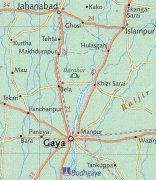Gaya (Gaya)
Gaya (IAST: Gayā) is a city, municipal corporation and the administrative headquarters of Gaya district and Magadh division of the Indian state of Bihar. Gaya is 116 km south of Patna and is the state's second-largest city, with a population of 470,839. The city is surrounded on three sides by small, rocky hills (Mangla-Gauri, Shringa-Sthan, Ram-Shila, and Brahmayoni), with the Phalgu River on its eastern side.
It is a city of historical significance and is one of the major tourist attractions in India. Gaya is sanctified in the Jain, Hindu, and Buddhist religions. Gaya district is mentioned in the great epics, the Ramayana and the Mahabharata. It is the place where Rama, with Sita and Lakshmana, came to offer piṇḍadāna for their father, Dasharatha, and continues to be a major Hindu pilgrimage site for the piṇḍadāna ritual. Bodh Gaya, where Buddha is said to have attained enlightenment, is one of the four holy sites of Buddhism.
Gaya was chosen as one of twelve heritage cities to benefit from the Government of India's four-year Heritage City Development and Augmentation Yojana (HRIDAY) scheme for urban planning, economic growth and heritage conservation projects.
The Mahabodhi Temple complex at Bodh Gaya is a World Heritage Site.
Gaya is named after the demon Gayasura (meaning "the demon Gaya") who dwelt the area during the Treta Yuga. According to Vayu Purana, Gaya was the name of a demon (Asura) whose body became pious after he performed strict penance and secured blessings from Lord Vishnu. It was said that the body of Gayasura was transformed into the series of rocky hills that make up the landscape of Gaya.
It is a city of historical significance and is one of the major tourist attractions in India. Gaya is sanctified in the Jain, Hindu, and Buddhist religions. Gaya district is mentioned in the great epics, the Ramayana and the Mahabharata. It is the place where Rama, with Sita and Lakshmana, came to offer piṇḍadāna for their father, Dasharatha, and continues to be a major Hindu pilgrimage site for the piṇḍadāna ritual. Bodh Gaya, where Buddha is said to have attained enlightenment, is one of the four holy sites of Buddhism.
Gaya was chosen as one of twelve heritage cities to benefit from the Government of India's four-year Heritage City Development and Augmentation Yojana (HRIDAY) scheme for urban planning, economic growth and heritage conservation projects.
The Mahabodhi Temple complex at Bodh Gaya is a World Heritage Site.
Gaya is named after the demon Gayasura (meaning "the demon Gaya") who dwelt the area during the Treta Yuga. According to Vayu Purana, Gaya was the name of a demon (Asura) whose body became pious after he performed strict penance and secured blessings from Lord Vishnu. It was said that the body of Gayasura was transformed into the series of rocky hills that make up the landscape of Gaya.
Map - Gaya (Gaya)
Map
Country - India
 |
 |
| Flag of India | |
Modern humans arrived on the Indian subcontinent from Africa no later than 55,000 years ago. Their long occupation, initially in varying forms of isolation as hunter-gatherers, has made the region highly diverse, second only to Africa in human genetic diversity. Settled life emerged on the subcontinent in the western margins of the Indus river basin 9,000 years ago, evolving gradually into the Indus Valley Civilisation of the third millennium BCE. By, an archaic form of Sanskrit, an Indo-European language, had diffused into India from the northwest. (a) (b) (c), "In Punjab, a dry region with grasslands watered by five rivers (hence ‘panch’ and ‘ab’) draining the western Himalayas, one prehistoric culture left no material remains, but some of its ritual texts were preserved orally over the millennia. The culture is called Aryan, and evidence in its texts indicates that it spread slowly south-east, following the course of the Yamuna and Ganga Rivers. Its elite called itself Arya (pure) and distinguished themselves sharply from others. Aryans led kin groups organized as nomadic horse-herding tribes. Their ritual texts are called Vedas, composed in Sanskrit. Vedic Sanskrit is recorded only in hymns that were part of Vedic rituals to Aryan gods. To be Aryan apparently meant to belong to the elite among pastoral tribes. Texts that record Aryan culture are not precisely datable, but they seem to begin around 1200 BCE with four collections of Vedic hymns (Rg, Sama, Yajur, and Artharva)."
Currency / Language
| ISO | Currency | Symbol | Significant figures |
|---|---|---|---|
| INR | Indian rupee | ₹ | 2 |
| ISO | Language |
|---|---|
| AS | Assamese language |
| BN | Bengali language |
| BH | Bihari languages |
| EN | English language |
| GU | Gujarati language |
| HI | Hindi |
| KN | Kannada language |
| ML | Malayalam language |
| MR | Marathi language |
| OR | Oriya language |
| PA | Panjabi language |
| TA | Tamil language |
| TE | Telugu language |
| UR | Urdu |






















